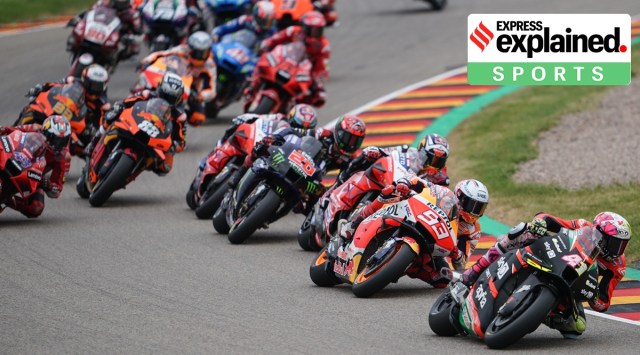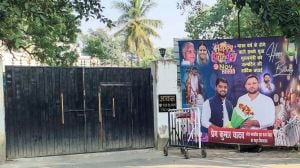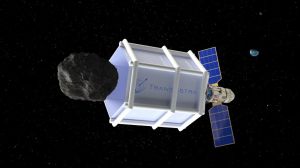In a little less than two months from now, the Buddh International Circuit (BIC) in Greater Noida will host the first-ever MotoGP Bharat race, thus making India the 31st country to host a motorcycle grand prix. While the Buddh circuit has hosted Formula 1 races in the past, this will be the first time that the premier race for motorcycles will be held in India.
For MotoGP, the race will break new ground.

“In the 30 years that Dorna has been managing MotoGP, there have been a lot of countries coming in and a lot of countries going out. Every single first event is special. But nothing has ever been like India. It’s the biggest two-wheeler market in the world,” Carlos Ezpeleta, chief sporting officer of Dorna Sports (the commercial rights holder for MotoGP), told The Indian Express earlier this month.
Ahead of the MotoGP caravan coming to town, here’s what goes on behind the scenes logistically to make the race happen:
Story continues below this ad
Did the track have to be remade to host a MotoGP race?
According to organisers, not too much work had to be put in to make the circuit — which has hosted three F1 races between 2011 and 2013 — fit to host a MotoGP race.
 Gautam Buddh Nagar Zone IG, Lakshmi Singh and other senior police officials visited the BIC on Saturday. (Express photo)
Gautam Buddh Nagar Zone IG, Lakshmi Singh and other senior police officials visited the BIC on Saturday. (Express photo)
Currently, there are only four circuits around the world that host both F1 and MotoGP races.
“A circuit can host both MotoGP and Formula 1 races. But we have higher demands in terms of safety because we need a lot of space for runoff areas for riders to be able to slide and not get hurt,” said Carlos.
Story continues below this ad
“Nothing major had to be changed at the track. We had to move certain portions of the fences back on some corners and the gravel had to be increased. The track is actually in very good shape, except for maybe one or two areas where we need to do resurfacing like the back straight, which is about a one-km patch. It had some bumps in it. The back straight has to be perfectly smooth as the MotoGP machine suspensions are extremely stiff and unforgiving,” Amit Sandill, who is Director of Racing at Fairstreet Sports, which is the local organiser for the race in India, told The Indian Express.
Special foam barriers and air fences are being imported for the race. While the track already had barriers, the reason why special ones are being brought in is because the old ones, used for cars, were installed over a decade back.
“The FIA’s homologation rules state that we need to have the latest version of barriers, which are safer than previous versions,” said Sandill, whose job it is to coordinate changes in the track, the homologation process, and communicating with bodies like Dorna Sports and FIM. FIA or the Fédération Internationale de l’Automobile is a global organisation whose stated aim is to promote motorsport and is also its governing body.
What’s homologation?
Homologation is the process of certifying if a track meets certain quality parameters and safety standards to host a MotoGP race. There are multiple checks run on the circuit by the FIM, which is the governing body for MotoGP, in the months leading up to a race before certifying the track.
Story continues below this ad
“The FIM, which takes care of the homologation, have visited the BIC a couple of times along with the Dorna Sports team. They will visit again in the summer to see how the works are going,” said Carlos. At the start of the season, MotoGP organisers had to cancel the ninth race of the season at Kazakhstan as the homologation process for the track outside Almaty was not completed in time.
Last year, Finland’s return to the MotoGP circuit was deferred by a season after the KymiRing circuit was not homologated in time.
Is there a final inspection to decide about the track being race-worthy?
The FIM, Dorna Sports and the IRTA (the riders association) have been doing constant inspections of the race track since late last year. This ensures that there are no last-minute surprises for the local organisers or the governing bodies.
Story continues below this ad
“There’s no such thing as a final inspection. Inspections happen almost every few days,” said Sandill.
The IRTA takes care of everything that has to do with the paddock since that’s where the teams live and work out of, said Carlos. The IRTA checks if the paddocks have things like good water supply, energy supply, and that they’re clean.
“The reason why these checks are so extensive is because we dash in from one country to another and then dash out. Everything has to be in place,” said Carlos.
For bikes to be brought into India for the MotoGP Bharat, there’s still some breathing space as there is a 10-day gap between the testing at Misano to the race in India.
Story continues below this ad
“But the process of moving the bikes out will have to be very efficient because the MotoGP race in Japan will be on the next weekend itself,” added Sandill.
Multiple teams, multiple lists
Each team competing across the three classes — MotoGP, Moto2 and Moto3 — has sent across their ‘check list’ of things they require in their offices. These lists note down something as basic as the number of chairs and tables needed, in offices that the teams will operate from during the race.
How are the bikes transported to India?
Barely 10 days before the first-ever MotoGP Bharat race at the Buddh International Circuit, four 747 Jumbo freighter aircraft will do all the heavy lifting for Dorna Sports, the organisers of the MotoGP. These four aircraft, travelling from Italy to India, will have about 800 crates crammed with 400 tonnes of freight, including finely-tuned, high-end motorbikes for all the teams across MotoGP, Moto2 and Moto3. The pit walls and equipment for all the riders will also be part of this.
Story continues below this ad
“It’s a huge operation. It happens on a bigger scale than people imagine. The bikes will be flown from Italy (where teams will be undergoing testing at the Misano Adriático circuit just 10 days before the MotoGP Bharat race),” Carlos said.
Earlier this month, about 20 containers carrying everything from special foam barriers to air fences were dispatched to India via sea freight along with other apparatus like broadcast equipment, tyres and fuel.



 Gautam Buddh Nagar Zone IG, Lakshmi Singh and other senior police officials visited the BIC on Saturday. (Express photo)
Gautam Buddh Nagar Zone IG, Lakshmi Singh and other senior police officials visited the BIC on Saturday. (Express photo)




































